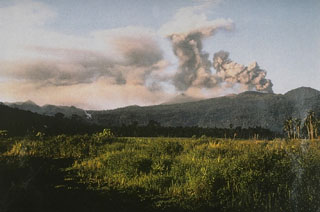Report on Dukono (Indonesia) — 6 March-12 March 2019
Smithsonian Institution / US Geological Survey
Weekly Volcanic Activity Report, 6 March-12 March 2019
Managing Editor: Sally Sennert.
Please cite this report as:
Global Volcanism Program, 2019. Report on Dukono (Indonesia) (Sennert, S, ed.). Weekly Volcanic Activity Report, 6 March-12 March 2019. Smithsonian Institution and US Geological Survey.
Dukono
Indonesia
1.6992°N, 127.8783°E; summit elev. 1273 m
All times are local (unless otherwise noted)
Based on satellite images, wind model data, and ground observations, the Darwin VAAC reported that during 5-9 and 11-12 March ash plumes from Dukono rose to altitudes of 1.8-2.4 km (6,000-8,000 ft) a.s.l. and drifted WSW, SW, S, and SE. The Alert Level remained at 2 (on a scale of 1-4), and visitors were warned to remain outside of the 2-km exclusion zone.
Geological Summary. The Dukono complex in northern Halmahera is on an edifice with a broad, low profile containing multiple peaks and overlapping craters. Almost continuous explosive eruptions, sometimes accompanied by lava flows, have occurred since 1933. During a major eruption in 1550 CE, a lava flow filled in the strait between Halmahera and the Gunung Mamuya cone, 10 km NE. Malupang Wariang, 1 km SW of the summit crater complex, contains a 700 x 570 m crater that has also had reported eruptions.
Sources: Darwin Volcanic Ash Advisory Centre (VAAC), Pusat Vulkanologi dan Mitigasi Bencana Geologi (PVMBG, also known as CVGHM)

